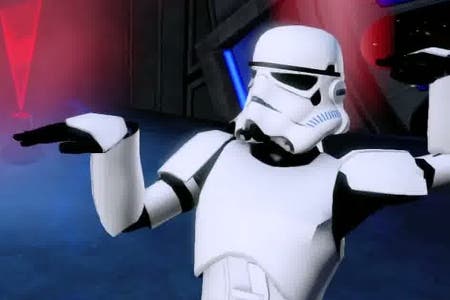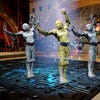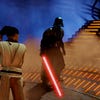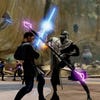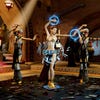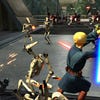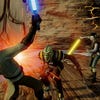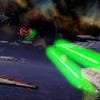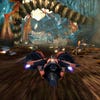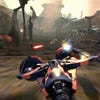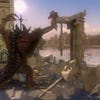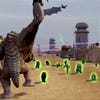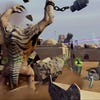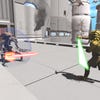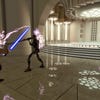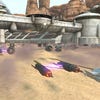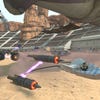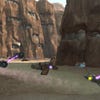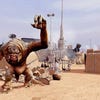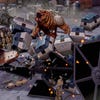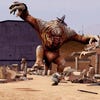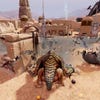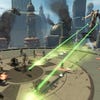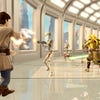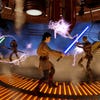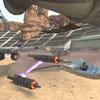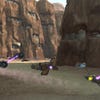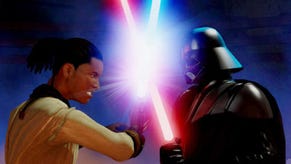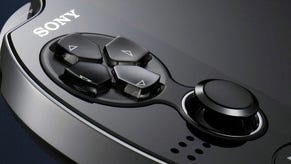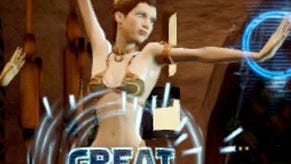Kinect Star Wars Review
Darth punk'd.
In concept alone, Kinect Star Wars seems to have been designed to create a perfect storm of nerdrage. It's a collection of casual motion-controlled mini-games, to start with, the sort of cheesy shallow product that has been proven to drive self-professed "hardcore" gamers into steaming tantrums of outrage and disgust.
It's also Star Wars, the franchise that beguiled and betrayed an entire generation, turning wide-eyed children of the 1980s into bitter, jilted adults in the 2000s. Punch-drunk as they are, even the weariest Star Wars fan must surely still bristle at the news that this game features Darth Vader singing a Village People disco hit.
That surreal moment, bizarrely, is also one of the game's best. For the most part, Kinect Star Wars is a half-hearted grab bag of ideas, few of which feel fully formed or have been executed with any polish. There's a story mode, of sorts, in which you play a Jedi padawan crammed into yet another prequel-era storyline. There's podracing too, as well as lightsaber duels, a dancing game and a mode in which you stomp around as a Rancor, causing as much damage as possible to various locations. It's all vaguely linked together by C-3PO and R2-D2, who have apparently been sent to the derelict Jedi Temple by Luke Skywalker to explore the archives.
Jedi Destiny is the story-based core of the game, but it's also the weakest element. You're a padawan, embroiled in a thin narrative about an attack on the Wookiee homeworld. In gameplay terms, that means you lurch through a series of on-rails scenarios with one hand guiding your lightsaber while the other struggles with fussy Force gestures.
It's a gauntlet, basically, as you clear room after room filled with battle droids and Trandoshan troops. Control is clumsy and vague, however, while Kinect simply can't cope with any fancy fighting moves. So you're stuck with broad, simple strokes, but even then it feels like the action on-screen is always one move behind what you're actually doing.
You can jump to somersault over enemies, while leaning side to side dodges. Leaning forwards while stretching your arms behind you supposedly propels you forwards in a Force Rush, but, like most of the interactions more complicated than waving your hand from side to side, the game only reacts sporadically or else misreads your moves completely.
It's one of those experiences where you can see what developer Terminal Reality was aiming for but the gulf between expectation and execution remains distractingly large. Combat is a fumble, accuracy is loose and unsatisfying, and you're constantly aware that for the most part progress comes about because the game keeps dragging you forwards.
In keeping with too many other Star Wars games (yes, Force Unleashed, we're looking at you), in order to stop the player simply cutting through the enemies like a chainsaw through cheesecake the Star Wars universe once again burps up a bunch of weapons and armour that can withstand lightsaber attacks and repel the Force.
This is most evident in the long-winded duels, where you must first block heavily telegraphed attacks then knock your foe off-balance and retaliate. Once again, sluggish response kills any flow the game might have, while the sight of a Jedi flapping their saber around to very little effect actively works against the appeal of Star Wars at a deep level.
Occasionally the monotonous melee action is broken up by a speeder bike chase, some space-bound turret action or basic "jump now" platforming, but that simply serves to make the game feel even more piecemeal, a compilation brought about by the question "what else can we put in here that might work?" rather by any urgent gameplay necessity.
It's also short, with just three slender chapters that spend most of their time copying key moments from the original trilogy but without any sense of narrative purpose or character fun. There's no Han Solo, but there is a Han Solo character. There's a bit on a sail barge with a Sarlaac. You don't fly the Millennium Falcon, but you fly around in a ship that looks the same with Chewie as your co-pilot. You don't attack the Death Star, but you do fly into the bowels of a large destroyer in much the same way.
On and on it goes, often feeling more like an unauthorised rip-off of a Star Wars story than anything officially sanctioned. Only occasional cameos from Yoda, Mace Windu and Obi Wan make it feel authentic, but even then the incredibly weak voice impersonations give it a cheap feel. When even Anthony Daniels doesn't show up to voice Threepio, you know the bar has been set incredibly low.
The Duels mode is essentially a spin-off from the story, using the same lumpen block-and-strike mechanism as Jedi Destiny's boss battles, but it does finally pit you against worthy foes like Darth Vader rather than anonymous droids and generic Sith lords.
Podracing suffers from the same feature creep as Jedi Destiny, taking a basic concept that should work and then smothering it in complex gestures that only serve to undermine the fun. Actually steering the pod is intuitive and surprisingly accurate - you hold both arms out in front of you and then pull them back to steer, so pulling your right arm towards you makes you drift right, for example, which is simple and effective - but then the game clutters things up.
First you have to wave your hands in front of you to wipe steam and moisture off your visor. Then you have to thrust your arms side to side to swipe other racers. Punch one arm up in the air to repair damage, or the other to lob weapons. Throw things at droids and critters who jump aboard your pod. It's too much and, because you are the controller, every time you're forced to do one of these superfluous movements, you're no longer steering. Precision play therefore becomes another fumble between you and Kinect, and what should have been exhilarating becomes frustrating instead.
Rancor Rampage has similar problems with accuracy, but wisely has a gameplay shell where precision is less important. As the name suggests, the inspiration has old-school arcade roots, but the implementation owes more to the demolition gameplay of Red Faction. Motions are intuitive - you're simply throwing a big tantrum - and structure comes from randomly generated goals, such as "Destroy two buildings" or "Throw a bystander 100m". Perform these feats in time and you earn extra points, which count towards unlocking perks such as score multipliers and new monsters.
There's still an irritating lack of connection between what you want to do and what the game actually registers, but the chaotic nature of the mode compensates slightly and there's a malevolent mean-spiritedness to the action that makes it stand out from the usual heroic trajectory of most Star Wars games. More than anything, it keeps things mostly within the limits of the hardware, and taps into something that is simply fun to do: smashing stuff.
Fun is also on the menu for the game's much-maligned dancing mini-game. There's no denying that a Dance Central style mode in amongst the monsters and lightsabers makes for an incongruous selection, but that's part of its charm.
In locations ranging from Jabba's palace to the Death Star itself, this mode suggests an alternative Star Wars universe where real-world pop songs are given a sci-fi twist and galactic strife is solved through a good old fashioned dance-off. It's silly, camp and - perhaps not unrelated - the only part of Kinect Star Wars that feels like a throwback to the Star Wars of the 1970s, back when it was a genuine mainstream pop phenomenon embraced by all and not a nerd ghetto swamped by its own pompous mythology.
Fans, of course, will hate it, but that doesn't alter the fact that it's also the only section of Kinect Star Wars where both gameplay and technology feel in perfect harmony. There's not much kudos to be earned by getting a dancing game right in 2012, but the sight of Princess Leia poppin' and lockin' while Vader rocks the disco is the only moment when this patchwork title not only comes to life. All the same, it feels like the work of people exploring beyond the margins of what's expected from the licence.
Overall, Kinect Star Wars is an incoherent and clumsy compilation, one driven more by brand synergy than any creative imperative. The better elements would arguably have worked better as standalone digital releases, while the core gameplay is both awkward and unsatisfying. Kids will find it far too fiddly and unresponsive, while adults will be put off by the repetition and generally slapdash "see what sticks" approach to gameplay. Waste your time with this, you should not.
